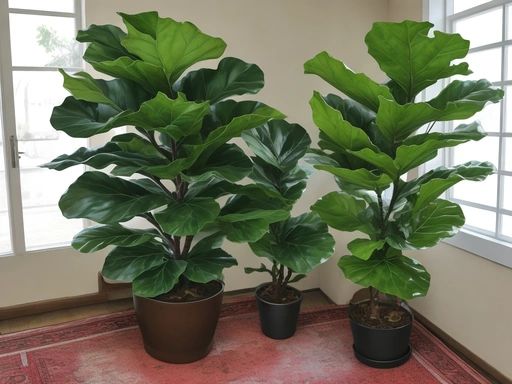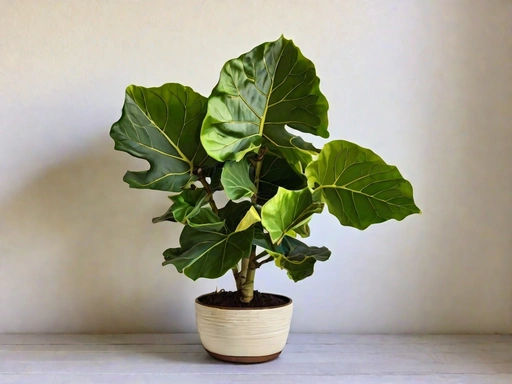Fiddle-Leaf Fig Soil And Potting Tips: The Ultimate Guide
Key Takeaways:
- Use well-draining soil to prevent root rot in fiddle-leaf figs.
- Choose a pot with drainage holes to allow excess water to escape.
- Let the top inch of soil dry out before watering your fiddle-leaf fig.
- Consider adding perlite or peat moss to your potting mix for optimal soil moisture control.
Are you struggling to keep your fiddle-leaf fig plant healthy and thriving? Well, look no further because I’ve got some soil and potting tips that will turn your green thumb dreams into a reality! Understanding the unique characteristics and care requirements of these stunning plants is key to their success.
But it all starts with choosing the right soil and pot.
In this article, I’ll walk you through the importance of soil selection, pot options, and essential potting techniques. Get ready to take your fiddle-leaf fig game to the next level, and say goodbye to wilted leaves and weak growth!
| Soil | Potting Tips |
|---|---|
| Well-draining soil mix | Use a well-draining potting mix that retains some moisture but allows excess water to drain easily. Choose a mix specifically formulated for indoor plants or mix equal parts of potting soil, perlite, and peat moss. |
| Organic matter | Incorporate organic matter, such as compost or aged manure, into the soil mix. This helps improve nutrient retention and soil structure. |
| pH level | Ensure the soil pH is slightly acidic to neutral, ideally around 6.0 to 7.0, for optimal growth. |
| Aeration | Avoid compacting the soil around the plant’s roots to allow proper airflow and prevent root rot. Regularly loosen the soil using a hand fork or gently brush away any compacted soil on the surface. |
| Drainage | Ensure proper drainage by using a pot with drainage holes and placing a layer of gravel or broken pottery at the bottom of the pot. This prevents water from pooling around the roots. |
| Size of pot | Choose a pot slightly larger than the current root ball to allow room for growth. However, avoid using a pot too large as it can lead to overwatering and slow growth. |
Understanding the Fiddle-Leaf Fig Plant
The Fiddle-Leaf Fig plant is a popular houseplant known for its large, violin-shaped leaves.
Understanding its characteristics and care requirements is essential for keeping it happy and healthy.
Characteristics and Care Requirements of the Fiddle-Leaf Fig
The Fiddle-Leaf Fig is a popular indoor plant known for its large, glossy leaves and tree-like appearance.
It requires bright, indirect light and a warm, humid environment.
Regular watering and well-draining soil are important, but be careful not to overwater.
Avoid cold drafts and temperature extremes.
Pruning and fertilization can help maintain its shape and health.
Monitor for pests like spider mites and treat as needed.
Overall, the Fiddle-Leaf Fig needs proper care to thrive indoors.
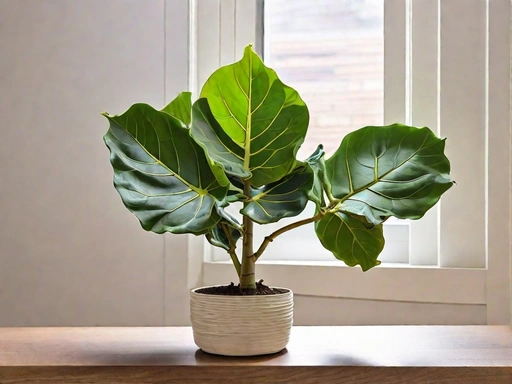
Importance of Choosing the Right Soil for Your Fiddle-Leaf Fig
Choosing the right soil for your fiddle-leaf fig is essential for its overall health and growth.
Why Soil Matters for Fiddle-Leaf Fig Plants
Why Soil Matters for Fiddle-Leaf Fig Plants: The soil you choose for your fiddle-leaf fig is important because it directly affects the health and growth of the plant. The right soil will provide proper drainage, nutrients, and aeration for the roots.
It should also have the right texture to hold moisture without becoming waterlogged.
By using the right soil, you can ensure that your fiddle-leaf fig thrives and stays healthy.
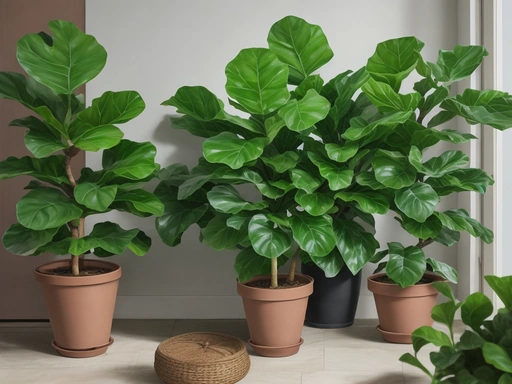
Characteristics of Ideal Soil for Fiddle-Leaf Figs
The ideal soil for fiddle-leaf figs is well-draining and nutrient-rich.
It should retain moisture without becoming waterlogged.
A mix of peat moss, perlite, and compost is recommended.
Avoid heavy or compacted soils that can lead to root rot.
Regularly check the soil moisture and adjust watering accordingly.
Purchasing the Right Pot for Your Fiddle-Leaf Fig Plant
Choosing the right pot for your fiddle-leaf fig is important for its health and growth.
Choosing the Right Size Pot for Your Fiddle-Leaf Fig
Choosing the right size pot for your fiddle-leaf fig is important for its health and growth. A pot that is too small can restrict root growth, while a pot that is too large can hold excess moisture.
The general rule is to choose a pot that is 2 inches larger in diameter than the current pot.
Ensure the pot has drainage holes to prevent overwatering.
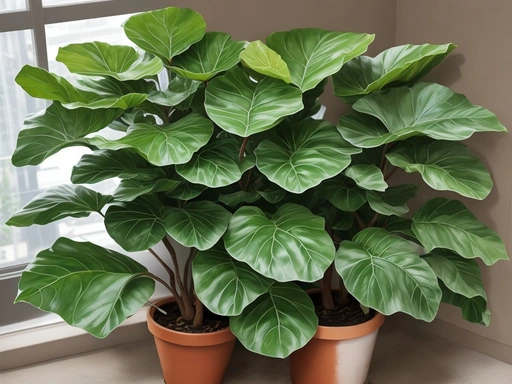
Materials and Drainage Considerations for Fiddle-Leaf Fig Pots
Drainage is key when choosing a pot for your fiddle-leaf fig. Look for pots made of breathable materials like terra cotta or ceramic that allow excess water to evaporate.
Avoid pots with no drainage holes, as they can lead to root rot.
If you love a pot without drainage holes, use a saucer or liner to catch excess water.
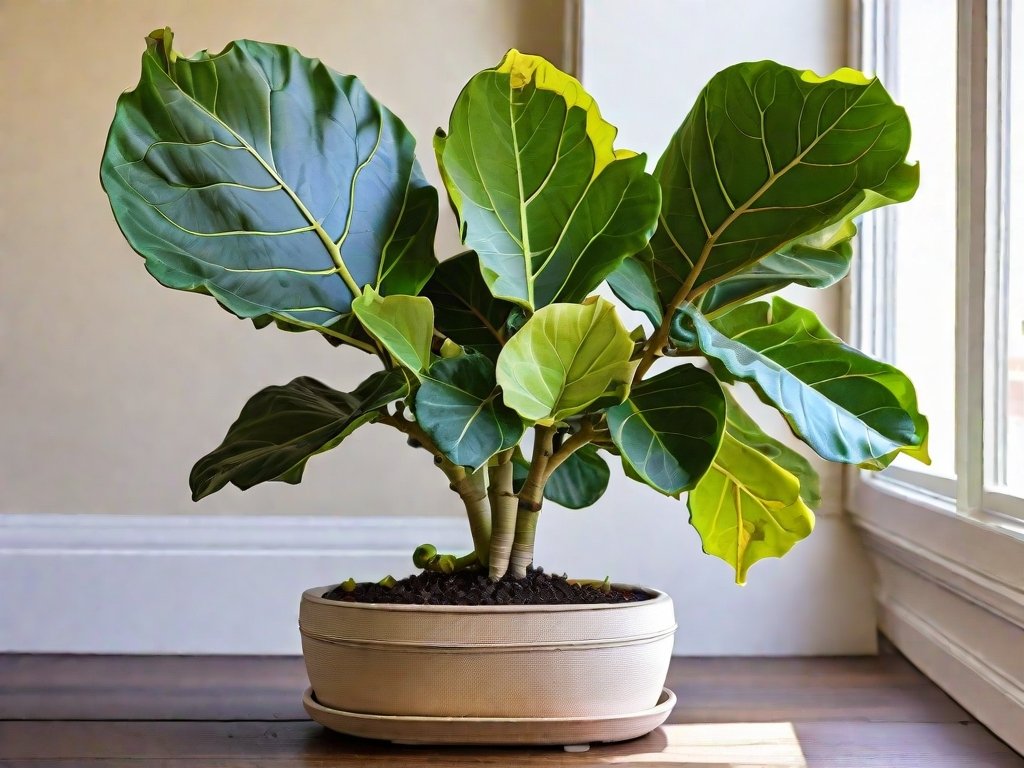
Potting Tips for Your Fiddle-Leaf Fig Plant
Potting your fiddle-leaf fig properly is essential for its health and growth.
Understanding Proper Potting Techniques for Fiddle-Leaf Figs
Understanding proper potting techniques is important for the health and growth of your fiddle-leaf fig plant.
Here are some key tips:
- Choose the right pot size: Opt for a pot that is only slightly larger than the current one to avoid excessive soil moisture. A pot with drainage holes is crucial to prevent waterlogging.
- Use well-draining soil: Fiddle-leaf figs prefer soil that allows water to flow through easily. A mixture of peat moss, perlite, and regular potting soil works well.
- Position the plant correctly: When potting or repotting your fiddle-leaf fig, ensure it sits at the same depth as it was in the previous pot. Avoid burying the stem too deep as it can lead to root rot.
- Pat down the soil: Gently press the soil around the base of the plant to ensure it is secure and stable.
- Water moderately: After potting, water your fiddle-leaf fig until it starts to drain from the bottom. Then, allow the top inch of soil to dry out before watering again.
Maintaining the Health and Growth of Your Fiddle-Leaf Fig
To ensure the health and growth of your fiddle-leaf fig, focus on proper watering and drainage techniques, as well as regular fertilizing and pruning.
Watering and Drainage Tips for Fiddle-Leaf Figs
To ensure the health and growth of your fiddle-leaf fig, here are some watering and drainage tips:
- Check the soil moisture: Stick your finger about an inch into the soil. If it feels dry, it’s time to water. If it feels moist, wait a bit longer.
- Water thoroughly: When watering, make sure to thoroughly soak the soil until water drains out of the bottom of the pot. This helps prevent waterlogged roots.
- Avoid overwatering: Fiddle-leaf figs don’t like to sit in soggy soil, so be careful not to overwater. Only water when the top inch of soil is dry.
- Use well-draining soil: The soil should be well-draining to prevent water from pooling around the roots. You can mix in perlite or orchid bark to improve drainage.
- Don’t let the roots sit in water: Make sure your pot has drainage holes and use a saucer or tray to catch excess water. Empty the saucer after watering to prevent the roots from sitting in water.
Fertilizing and Pruning for Optimal Fiddle-Leaf Fig Growth
To ensure optimal growth of your fiddle-leaf fig, it’s important to fertilize and prune it regularly. Fertilize your plant every 4-6 weeks during the growing season using a balanced liquid fertilizer.
Prune your fiddle-leaf fig to control its size and shape, removing any dead or damaged leaves or branches.
Avoid over-pruning, as this can stress the plant. Regular fertilizing and pruning will help promote healthy growth and keep your fiddle-leaf fig looking its best.
Common Problems and Solutions for Fiddle-Leaf Fig Plants
Having common problems with your Fiddle-Leaf Fig?
Here are some solutions for you.
Identifying and Addressing Overwatering or Underwatering Issues
Overwatering your fiddle-leaf fig can lead to root rot and droopy leaves, while underwatering can cause wilting and dryness.
To identify overwatering, check if the soil is constantly wet, and the roots appear mushy.
For underwatering, the soil will be dry, and the leaves may turn brown and crispy.
Adjust watering habits accordingly to ensure your fiddle-leaf fig’s health.
Dealing with Pests and Diseases that Affect Fiddle-Leaf Figs
Dealing with pests and diseases that affect fiddle-leaf figs can be a challenge, but it’s important to address them promptly to keep your plant healthy.
Here are some key tips:
- Identify the problem: Look for signs of pests like spider mites, mealybugs, or scale insects. Common diseases include root rot and leaf spot. Proper identification is crucial for effective treatment.
- Isolate and treat: If you notice pests or diseases, isolate the affected plant from others to prevent further spread. Treatments may include using insecticidal soap or neem oil for pests, and adjusting watering habits or applying fungicides for diseases.
- Regular maintenance: Keep your fiddle-leaf fig healthy by providing optimal growing conditions. This includes proper watering, providing adequate sunlight, and ensuring good air circulation.
- Prevention is key: Maintain good plant hygiene by regularly inspecting your fiddle-leaf fig for signs of pests or diseases. Clean leaves with a damp cloth, monitor soil moisture levels, and avoid overwatering.
Frequently Asked Questions about Fiddle-Leaf Fig Soil and Potting
How often should I repot my fiddle-leaf fig?
The fiddle-leaf fig should be repotted every 1 to 2 years, or when the current pot becomes too small for the roots to grow.
Look for signs such as roots growing out of the drainage holes or the plant becoming top-heavy.
Always choose a pot that is slightly larger than the current one to allow for growth.
Can I use regular potting soil for my fiddle-leaf fig?
No, regular potting soil is not recommended for fiddle-leaf figs.
They require a well-draining and nutrient-rich soil mixture that mimics their native environment.
Using regular potting soil may lead to poor drainage and nutrient deficiencies, potentially harming the health of your plant.
It’s best to use a specialized soil mix formulated for fiddle-leaf figs.
What are some signs that my fiddle-leaf fig needs to be repotted?
Some signs that your fiddle-leaf fig needs to be repotted include roots poking out of the drainage holes, the plant becoming top-heavy and leaning, slow growth or stunted development, yellowing or wilting leaves, and the soil drying out quickly after watering. Keep an eye out for these indicators to ensure your fiddle-leaf fig stays healthy and happy.
Final Verdict
Understanding the characteristics and care requirements of the fiddle-leaf fig plant is crucial for its health and growth.
Choosing the right soil and pot is essential for providing the proper environment for your plant.
Proper potting techniques and maintenance, such as watering, fertilizing, and pruning, will help ensure the longevity and vitality of your fiddle-leaf fig.
Additionally, being able to identify and address common problems such as overwatering, underwatering, pests, and diseases will help keep your plant thriving.
By following these guidelines and implementing the practical tips provided, you can enjoy a beautiful and vibrant fiddle-leaf fig in your home for years to come.

